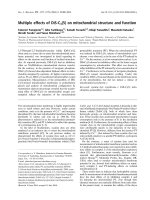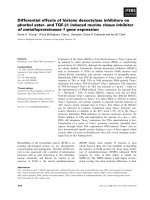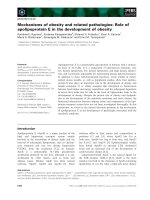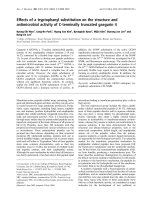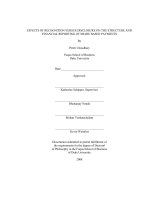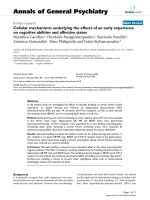Age related effects of apolipoprotein e genotypes on cholesterol metabolism and insulin signaling
Bạn đang xem bản rút gọn của tài liệu. Xem và tải ngay bản đầy đủ của tài liệu tại đây (2.17 MB, 145 trang )
AGE‐RELATEDEFFECTSOFAPOLIPOPROTEINEGENOTYPESON
CHOLESTEROLMETABOLISMANDINSULINSIGNALING
ONG Qi Rui
BSc (Hons), UQ, Australia
A THESIS SUBMITTED
FOR THE DEGREE OF DOCTOR OF PHILOSOPHY
DEPARTMENT OF PHYSIOLOGY
NATIONAL UNIVERSITY OF SINGAPORE
2013
Table of Contents
Declaration .......................................................................................................vii
Summary ........................................................................................................ viii
List of figures ..................................................................................................... x
List of tables.....................................................................................................xii
List of abbreviations ...................................................................................... xiii
List of publications .......................................................................................... xv
Acknowledgements ......................................................................................... xvi
1 Introduction ..................................................................................................... 2
1.1 Apolipoprotein E (ApoE)......................................................................... 2
1.1.1 Characteristics of Apolipoprotein E.................................................. 2
1.1.2 Functions of Apolipoprotein E.......................................................... 3
1.2 Glucose metabolism in the CNS .............................................................. 7
1.2.1 Glucose hypometabolism in diabetic and Alzheimer’s disease
patients ....................................................................................................... 7
1.2.2 Role of insulin in the central nervous system ................................... 9
1.2.3 PI3K/AKT signalling pathway in the central nervous system ........ 10
1.2.4 Insulin affects cognitive performance ............................................. 13
1.3 Apolipoprotein E and neurological diseases .......................................... 15
1.3.1 Alzheimer’s disease ........................................................................ 15
1.3.2 Niemann-Pick type C (NPC) disease .............................................. 17
i|Page
2 Materials and methods .................................................................................. 20
2.1 Animal models ....................................................................................... 20
2.2 Preparation of brain homogenates ......................................................... 21
2.3 Preparation of liver homogenates .......................................................... 22
2.4 Protein quantification of lysates............................................................. 22
2.5 SDS-PAGE and Western blot analysis .................................................. 23
2.6 Amplex red glucose assay ...................................................................... 26
2.7 Amplex red cholesterol assay ................................................................ 27
2.8 Insulin ELISA ........................................................................................ 27
2.9 Real-time PCR analysis ......................................................................... 28
2.9.1 Isolation of total RNA ..................................................................... 28
2.9.2 Reverse transcription of RNA......................................................... 28
2.9.3 Real-time PCR ................................................................................ 29
2.9.4 TaqMan® probes ............................................................................ 30
3 Impaired lipid metabolism and insulin signalling in Niemann-Pick type C
animal model.................................................................................................... 32
3.1 Introduction ............................................................................................ 32
3.1.1 Apolipoproteins and cholesterol linked diseases ............................ 32
3.1.2 NPC transgenic mouse model ......................................................... 33
3.1.3 Cholesterol dysfunction may have resulted in neurological problems
in NPC patients and mouse models ......................................................... 34
3.1.4 NPC patients and mouse models develop metabolic symptoms ..... 35
ii | P a g e
3.1.5 Hypothesis....................................................................................... 35
3.2 Results .................................................................................................... 37
3.2.1 Glucose and insulin profiles of NPCNIH mouse brains ................... 37
3.2.2 Western blot analysis of PI3K/AKT signalling pathway in NPCNIH
mouse brains ............................................................................................ 38
3.2.3 Aebp1 activity in the CNS of NPCNIH mouse model ...................... 41
3.2.4 GSK3β activity in the CNS of NPCNIH mouse model .................... 42
3.2.5 Expression of glucose transporters in the CNS of NPCNIH mouse
model........................................................................................................ 43
3.3 Discussion .............................................................................................. 44
3.3.1 Cholesterol dysfunction and abnormal insulin profiles in the CNS of
NPCNIH mouse model............................................................................... 44
3.3.2 Age dependent attenuated PI3K/AKT signalling in NPCNIH mouse
model........................................................................................................ 46
3.3.3 The effects of attenuated PI3K/AKT signalling pathway in NPCNIH
mouse model ............................................................................................ 49
3.3.4 Aebp1 mediated AKT signalling .................................................... 52
3.4 Summary ................................................................................................ 55
4 Human apolipoprotein E polymorphism affects brain insulin signalling in a
mouse model .................................................................................................... 57
4.1 Introduction ............................................................................................ 57
4.1.1 Human apolipoprotein E isoforms and diseases ............................. 57
iii | P a g e
4.1.2 Knowledge from NPC studies ........................................................ 57
4.1.3 HuApoE targeted replacement (TR)mouse model .......................... 58
4.1.4 HuApoE expression profiles in ApoE3/4 carriers and B6.129P2Apoetm3(APOE*3/4)Mae N8 mouse models....................................................... 59
4.1.5 Cholesterol profiles in ApoE3/4 carriers and B6.129P2Apoetm3(APOE*3/4)Mae N8 mouse models....................................................... 60
4.1.6 Hypercholesterolemia associated glucose and insulin profiles ....... 61
4.1.7 Experimental considerations ........................................................... 62
4.1.8 Hypothesis....................................................................................... 63
4.2 Results .................................................................................................... 64
4.2.1 Total cholesterol in the brain and plasma of female huApoE TR
mouse models........................................................................................... 64
4.2.2 HuApoE expression in the CNS of female huApoE TR mouse
models ...................................................................................................... 65
4.2.3 Glucose and insulin level in the brain and plasma of female huApoE
TR mouse models .................................................................................... 67
4.2.4 PI3K/AKT protein profile in the CNS of huApoE3 and huApoE4
TR mice.................................................................................................... 70
4.3 Discussion .............................................................................................. 77
4.3.1 Cholesterol, glucose and insulin profiles in the CNS of human
apolipoprotein TR mouse models ............................................................ 77
4.3.2 huApoE protein level in the CNS ................................................... 79
4.3.3 Loss of IRS2 in the CNS of huApoE4 TR mouse model ............... 80
iv | P a g e
4.3.4 PI3K/AKT signalling in the CNS of huApoE TR mouse models .. 81
4.3.5 Lower GluT4 expression complements the observations in
PI3K/AKT signalling pathway ................................................................ 83
4.4 Summary ................................................................................................ 85
5 Human apolipoprotein E polymorphism affects insulin signalling in the liver
of huApoE TR mouse models .......................................................................... 88
5.1 Introduction ............................................................................................ 88
5.1.1 Apolipoprotein E isoforms affects plasma cholesterol ................... 88
5.1.2 Apolipoprotein E and glucose metabolism ..................................... 89
5.1.3 Knowledge from previous studies .................................................. 90
5.1.4 Experimental considerations ........................................................... 90
5.1.5 Hypothesis....................................................................................... 91
5.2 Results .................................................................................................... 92
5.2.1 Total cholesterol in the liver of female huApoE3 and huApoE4 TR
mouse models........................................................................................... 92
5.2.2 HuApoE expression of female huApoE3 and huApoE4 TR mice .. 93
5.2.3 Glucose and insulin level in the liver of female huApoE3 and
huApoE4 TR mice ................................................................................... 94
5.2.4 PI3K-AKT protein profile in the liver of huApoE3 and huApoE4
TR mice.................................................................................................... 95
5.3 Discussion ............................................................................................ 102
5.3.1 Cholesterol and glucose metabolism in the liver .......................... 102
v|Page
5.3.2 HuApoE isoforms and PI3K-AKT signalling pathway ................ 104
5.4 Summary .............................................................................................. 107
6 Concluding remarks .................................................................................... 109
7 Bibliography ............................................................................................... 112
vi | P a g e
Declaration
I hereby declare that this thesis is my original work and it has been written by
me in its entirety. I have duly acknowledged all the sources of information
which have been used in the thesis.
This thesis has also not been submitted for any degree in any university
previously.
_______________________
ONG Qi Rui
13 Nov 2012
vii | P a g e
Summary
Apolipoprotein E (ApoE) plays an important role in the regulation of lipid
metabolism in the hepatic and central nervous system (CNS). HuApoE4
carriers have been associated with higher peripheral cholesterol level and
increased risk for atherosclerosis. Surprisingly, my data showed that huApoE4
has little impact on brain cholesterol metabolism. HuApoE4 isoform is also
known to accelerate memory decline in ageing and certain neurological
diseases but the molecular mechanism remains elusive.
Transgenic mouse models bearing phenotypic resemblance to human diseases
are commonly used to study and dissect molecular relevant pathways. My data
showed that an established mouse model for the human Niemann-Pick type C
(NPC) disease exhibits varying ApoE present in its CNS. Extensive
neurodegeneration and abnormal metabolic profiles in the CNS have been
reported. My results showed that the PI3K/AKT signalling pathway was
disrupted in the CNS of NPC mouse model. The PI3K/AKT pathway plays a
key role in multiple cellular processes such as glucose metabolism and GSK3β
activity.
Genetic modified huApoE3/E4 mouse models were used to study the effects
of huApoE genetic polymorphism. These animals exhibited distinct glucose
metabolic profiles and changes in the PI3K/AKT signalling pathway. Similar
observations were made in the peripheral and CNS. These findings uncovered
potential molecular pathways associated with glucose dysfunction. I have also
noticed that most of these molecular changes were evident in older mice.
viii | P a g e
These strongly suggest that ageing plays an important role together with the
huApoE. Collectively, my data suggests a novel role for huApoE in regulating
brain insulin signalling.
ix | P a g e
List of figures
Figure 1 Schematic diagram of insulin driven AKT activation ....................... 12
Figure 2 Insulin level of Balb/c wildtype and NPCNIH mouse brain lysates.... 37
Figure 3 Amplex red glucose assays of Balb/c wildtype and NPCNIH mouse
brain lysates ..................................................................................................... 38
Figure 4 Brain insulin receptor substrate (IRS) protein expression level in
Balb/c wildtype and NPCNIH mouse brain lysates ........................................... 39
Figure 5 Protein expression of key targets in PI3K/AKT signalling pathway of
Balb/c wildtype and NPCNIH mouse brain lysates ........................................... 40
Figure 6 Protein expression of Aebp1 and PTEN in Balb/c wildtype and
NPCNIH mouse brain lysates ............................................................................ 41
Figure 7 GSK3β activity in Balb/c wildtype and NPCNIH mouse brain lysates
.......................................................................................................................... 42
Figure 8 Expression of glucose transporters in Balb/c wildtype and NPCNIH
mouse brain lysates .......................................................................................... 43
Figure 9 Schematic diagram of how ApoE may modulate GSK3β activity in
the CNS of NPCNIH mice ................................................................................. 50
Figure 10 Schematic diagram proposing possible links across NPC1, ApoE
and lipid metabolism in the CNS ..................................................................... 54
Figure 11 Total amount of cholesterol in plasma and brain lysates of huApoE3
and huApoE4 TR mice..................................................................................... 64
Figure 12 Relative quantification of huApoE mRNA in the brain of huApoE3
and huApoE4 TR mice..................................................................................... 65
Figure 13 Brain huApoE protein expression level in the brain of huApoE3 and
huApoE4 TR mice ........................................................................................... 66
x|Page
Figure 14 Total glucose and insulin in brain lysates of huApoE3 and huApoE4
TR mice ............................................................................................................ 67
Figure 15 Total glucose and insulin in plasma samples of huApoE3 and
huApoE4 TR mice ........................................................................................... 68
Figure 16 Brain insulin receptor substrate (IRS) protein expression level of
huApoE3 & E4 TR mice .................................................................................. 72
Figure 17 Brain insulin receptor (IR) protein expression level of huApoE3 &
E4 TR mice ...................................................................................................... 73
Figure 18 Brain phosphatidylinositol 3-kinases (PI3K) protein expression level
of huApoE3 & E4 TR mice across 12-72 weeks. ............................................ 74
Figure 19 Brain AKT protein expression level of huApoE3 & E4 TR mice ... 75
Figure 20 Brain glucose transporter 4 protein expression level of huApoE3 &
E4 TR mice ...................................................................................................... 76
Figure 21 Overall representation of my findings addressing the effects of
huApoE isoform and ageing on PI3K/AKT signalling in the CNS ................. 85
Figure 22 Total amount of cholesterol of liver lysates in female huApoE3 and
huApoE4 TR mice ........................................................................................... 92
Figure 23 Liver huApoE protein expression level in huApoE3 and huApoE4
TR female mice ................................................................................................ 93
Figure 24 Total glucose and insulin in liver lysates of female huApoE3 and
huApoE4 TR mice ........................................................................................... 94
Figure 25 Liver insulin receptor substrate (IRS) proteins expression level of
huApoE3 & E4 TR mice .................................................................................. 97
Figure 26 Liver insulin receptor (IR) proteins expression level of huApoE3 &
E4 TR mice ...................................................................................................... 98
xi | P a g e
Figure 27 Liver phosphatidylinositol 3-kinases (PI3K) proteins expression
level of huApoE3 & E4 TR mice ..................................................................... 99
Figure 28 Liver AKT proteins expression level of huApoE3 & E4 TR mice100
Figure 29 Liver glucose transporter 4 protein expression level of huApoE3 &
E4 TR mice .................................................................................................... 101
List of tables
Table 1 Different ApoE isoforms and its allelic frequency in the population
{Hauser, 2011 #710}. ........................................................................................ 2
Table 2 Plasma lipoproteins containing ApoE {Smith, 1978 #968}. ................ 4
Table 3 Primary antibodies used in immunoblotting analysis. ........................ 24
xii | P a g e
List of abbreviations
AD
Alzheimer’s disease
AEBP1
AE binding protein 1
AKT
Protein kinase B
ApoE
Apolipoprotein E
ApoER2
ApoE receptor 2
BBB
Blood brain barrier
Cdk5
Cyclin-dependent kinase 5
CE
Cholesteryl esters
CNS
Central nervous system
CSF
Cerebrospinal fluid
FoxO1
Forkhead box O1
GluT
Glucose transporters
GS
Glycogen synthase
GSK
Glycogen synthase kinase 3
HDL
High-density lipoproteins
IGF1Rβ
Insulin growth factor 1 receptor-beta
IR
Insulin receptor
IRS
Insulin receptor substrates
LDLR
Low density lipoprotein receptor
LDLs
Low-density lipoproteins
LRP1
LDLR related protein 1
LTD
Long-term depression
LTP
Long-term potentiation
MAPK
Ras/mitogen-activated protein kinase
xiii | P a g e
NPC
Niemann-Pick type C
PD
Parkinson disease
PDK1
3-phosphoinositide dependent protein kinase-1
PH-
Pleckstrin homology
PI3K
Phosphatidylinositol 3-kinases
PIP2
Phosphatidylinositol (4, 5)-bisphosphate
PIP3
Phosphatidylinositol (3, 4, 5)-trisphosphate
PKC
Protein kinase C
PL
Phospholipid
PTEN
Phosphatase and tensin homolog
RCT
Reverse cholesterol transport
RTK
Receptor tyrosine kinase
SH2-
Src homology 2
SNP
Single nucleotide polymorphism
T2DM
Type 2 diabetic mellitus
TG
Triglyceride
TNFα
Tumor necrosis factor-alpha
VLDLs
Very low-density lipoproteins
xiv | P a g e
List of publications
Qi-Rui Ong, Mei-Li Lim, Ching-Ching Chua, Nam Sang Cheung, BoonSeng Wong (2012). Impaired insulin signalling in an animal model of
Niemann-Pick Type C disease.
Biochem Biophys Res Commun. 2012 Aug 3;424(3):482-7. Epub 2012 Jul 6
xv | P a g e
Acknowledgements
It is a pleasure to thank the many people who made this thesis possible.
Foremost, I would like to express my sincere gratitude to my advisor Dr.
Wong Boon Seng for the continuous support of my Ph.D study and research,
for his patience, motivation, enthusiasm, and immense knowledge. His
guidance had helped me in many moments of my research journey.
I would also like to thank the members in my thesis advisory committee; Dr.
Tai E-Shyong and Dr. Deng Lih Wen for their helpful advice during
committee meeting sessions held to discuss my work progression.
Furthermore, I would like to thank my fellow former and present members of
the Wong Boon Seng Neurobiology Research group for their support and
encouragement over last five years. They include: Dr. Chua Li Min, Dr. Hou
Peiling, Dr. Hu Zeping, Jacqueline Ho, Chong Peyrou, Chua Ching Ching,
Lim Meili, Tan Tse Mien, Wong Huimin Ira, and Yong Shanmay. I would
also like to thank my research mates in the Centre for Life Sciences (CELS):
Dr. Alvin Loo, Dr. Irwin Cheah, Dr. Sebestian Scheffer and Dr. Tang Soon
Yew.
Finally, but first in my heart, many thanks to wife and family who have
provided all the support and encouragement throughout my post graduate
studies.
xvi | P a g e
CHAPTER 1
INTRODUCTION
1|Page
1 Introduction
1.1 Apolipoprotein E (ApoE)
1.1.1 Characteristics of Apolipoprotein E
Human ApoE is located on chromosome 19 encoding a 35 kDa
glycoprotein(Rall, Weisgraber et al. 1982) that exists in 3 isoforms, E2, E3
and E4 (Mahley 1988; Zannis, Kardassis et al. 1993). Although sequence
analysis has shown that ApoE4 is the ancestral state in humans (Hanlon and
Rubinsztein 1995), ApoE3 had increased in frequency through evolution as
the most common isoform. This is followed by ApoE4 and ApoE2. They
differ with a single amino acid at position 112 and 158 (Zannis, Breslow et al.
1982). These crucial amino acid changes alter the charge and stability of ApoE,
contributing to its distinctive physiological functions (Table 1).
Table 1 Different ApoE isoforms and its allelic frequency in the
population (Hauser, Narayanaswami et al. 2011).
ApoE3 is the most common allele among the population. ApoE2 and ApoE4
differ from ApoE3 by one amino acid at either 112 or 158 position.
Allelic Frequency
E2
E3
Isoform amino acid
differences
ApoE2
Cys 112
Cys 158
E2
ApoE3
Cys 112
Arg 158
E3
ApoE4
Arg 112
Arg 158
E4
1-2%
E4
~15%
1-2%
~55%
~25%
1-2%
ApoE belongs to a group of lipid carrier molecules that is vital in the
cholesterol homeostasis of the body, both the peripheral and the central
nervous system (CNS) (Brown and Goldstein 1986). It is one of the key
constituent of lipoproteins that regulates the metabolism of lipids in the body
2|Page
through ApoE receptors and related proteins. ApoE is widely expressed in
various tissues with the highest expression in liver and brain.
Emerging
studies have suggested that its functions may extend beyond lipid metabolism
to include maintenance of normal brain function and possible involvement in
neurological diseases (Mahley and Rall 2000; Mahley, Weisgraber et al. 2009).
Structural variations in ApoE isoforms might affect its preferential binding to
lipoprotein receptors in the peripheral and CNS which in turn could potentially
remodel the lipid metabolism and/or neuronal signalling respectively.
1.1.2 Functions of Apolipoprotein E
1.1.2.1 Peripheral system
Cholesterol is an essential component of cell structure and source of steroid
hormones in the cell. The hydrophobic nature of cholesterol presents an
obstacle to its distribution in the body. Henceforth robust and balance
mechanisms are in place to maintain the homeostasis of cholesterol in the
body. Lipid carriers such as apolipoproteins are deployed to package
cholesterol into lipoproteins in order to be transported around the body.
Cholesterol is delivered to the peripheral tissues from the liver in the form of
low-density lipoproteins (LDLs) and very low-density lipoproteins (VLDLs).
The cell cholesterol requirements are met through in situ synthesis and
absorption of VLDLs and LDLs. Excess cholesterol are subsequently excreted
from the peripheral tissue in the form of high-density lipoproteins (HDLs) into
the circulatory system and back to the liver. At the liver, the cholesterol are
3|Page
released from the bile into the intestinal tract to be excreted as faeces or
reabsorbed. This is known as the reverse cholesterol transport (RCT).
There are six major classes of apolipoproteins and our focus falls on ApoE.
ApoE is an integral component of chylomicrons, VLDLs and HDLs in the
peripheral system (Table 2). It operates as part of an anchoring mechanism
that aids in the transport of triglyceride (TG), phospholipid (PL), cholesteryl
esters (CE) and cholesterol into cells by mediating the binding and
internalization of these lipoprotein particles. ApoE has a strong affinity and is
the main ligand for members of the low density lipoprotein receptor (LDLR)
family found on liver and other tissues. This super family includes the LDLR,
LDLR related protein 1 (LRP1), VLDL receptor and ApoE receptor 2
(apoER2). Interaction of ApoE with LDLR mediates the removal of ApoEcontaining lipoproteins and modulates the homeostasis of lipids in the
peripheral system.
Table 2 Plasma lipoproteins containing ApoE (Smith, Pownall et al. 1978).
ApoE is present in three out of the four classes of lipoproteins in the peripheral
system.
Properties
Major
apolipoproteins
Minor
apolipoproteins
Chylomicrons
VLDL
ApoA-I
ApoB
ApoB
ApoC-I
ApoC
ApoC-II
ApoC-III
ApoE
ApoA-II
ApoA-I
ApoA-II
ApoE
ApoD
LDL
ApoB
HDL
ApoA-I
ApoA-II
ApoC
ApoC-I
ApoC-II
ApoC-III
ApoD
ApoE
4|Page
ApoE polymorphism has an influence in the plasma cholesterol level
(Boerwinkle, Visvikis et al. 1987). Clinical studies have shown that ApoE4 is
associated with higher plasma total cholesterol and LDL, followed by ApoE3
and ApoE2 (Ehnholm, Lukka et al. 1986; Eichner, Dunn et al. 2002). This is
largely attributed with ApoE4 preferential binding to VLDL and ApoE3 to
HDL (Nguyen, Dhanasekaran et al. 2010). Nonetheless, these observations
may be challenged by individual’s dietary fat intake and other lifestyle
behaviours (Petot, Traore et al. 2003).
The importance of ApoE in lipid metabolism is asserted with the extensive
accumulation of lipoproteins in the circulatory system of ApoE-null mouse
(Plump, Smith et al. 1992). In addition, a Western high fat diet further elevates
plasma cholesterol and aggravates atherosclerotic lesions (Zhang, Reddick et
al. 1992). On the other hand, overexpression of ApoE in transgenic mouse
drastically reduces plasma cholesterol and TG level, consequently eliminating
diet-induced hypercholesterolemia (Shimano, Yamada et al. 1992).
1.1.2.2 Central nervous system (CNS)
The human brain contains up to 25% of cholesterol that is essential for myelin
production, function and integrity. It is vital to maintain the cholesterol
homeostasis in the CNS (Dietschy and Turley 2004; Saher, Brugger et al.
2005). The CNS cholesterol is independently regulated from the peripheral
system. It is believed to be mainly synthesized by glial cells for the neurons
(Quan, Xie et al. 2003). The process to synthesize cholesterol is energy
intensive and thus it is more efficient for the astrocytes to carry out this role
5|Page
(Brecht, Harris et al. 2004; Xu, Bernardo et al. 2006). Cholesterol dysfunction
in the CNS has been associated with ageing and the development of certain
neurodegenerative diseases such as AD, Parkinson disease (PD) and NPC
(Simons and Ehehalt 2002; Karten, Hayashi et al. 2005).
The blood brain barrier (BBB) restricts the exchange of lipoproteins and ApoE
between
the
central
nervous
and
peripheral
systems.
Henceforth, the lipid composition and regulation in both systems function
independently. In the CNS, lipoproteins are primary synthesized by glial cells
(Roheim, Carey et al. 1979; Pitas, Boyles et al. 1987) and ApoE may play a
pivotal role in the transportation of these packages (Boyles, Zoellner et al.
1989; Goodrum 1991). An early study had shown that injury to the brain
resulted in increased ApoE protein in the brain (Poirier, Hess et al. 1991). It
was proposed that ApoE-containing lipoproteins were taken up by ApoE
receptor-rich neurons for repair (Ignatius, Gebicke-Harter et al. 1986; Boyles,
Zoellner et al. 1989).
HuApoE isoforms have been associated with risks to neurological diseases
(Corder, Saunders et al. 1993; Saunders, Strittmatter et al. 1993; Roses 1996;
Ashford 2004, Raber, 2004 #296). Other than huApoE isoforms, differential
expression level of huApoE proteins in the CNS is also linked to neurological
symptoms such as NPC and AD (Ramaswamy, Xu et al. 2005; Riddell, Zhou
et al. 2008; Sullivan, Han et al. 2011). More recently, there have been two
reports suggesting that brain huApoE regulates the clearance of Aβ which is a
6|Page
common hallmark for some neurological diseases, such as Alzheimer’s disease
(Kim, Jiang et al. 2011; Bien-Ly, Gillespie et al. 2012).
1.2 Glucose metabolism in the CNS
Glucose is the most common source of energy for the body and it is important
to maintain its regulation. In the peripheral system, an overdose of blood
glucose may lead to diabetes mellitus while low blood glucose can result in
hypoglycaemia (Weyer, Bogardus et al. 1999; Schwartz and Porte 2005).
Abundant amount of blood glucose will lead to increase metabolism in the
pancreatic β cells. This leads to an elevation of insulin and kicks off a series of
insulin signalling linked pathways.
1.2.1 Glucose hypometabolism in diabetic and Alzheimer’s disease
patients
Type 2 diabetic mellitus (T2DM) patients typically suffer from glucose
dysfunction due to impairments in the insulin signalling pathway (Niswender,
Morrison et al. 2003; Plum, Belgardt et al. 2006). The human brain consumes
up to 30% of the total body glucose, thus glucose regulation plays an
important role in the CNS. Any disruption to glucose regulation may affect the
health of the CNS. It is widely recognized that hypometabolism occurs in
certain regions of the brain for AD patients and also elderly population
(Mosconi, Sorbi et al. 2004; Samuraki, Matsunari et al. 2012). It is still unclear
if hypometabolism is associated to neurodegeneration in the CNS. (Jack,
Knopman et al. 2010).
7|Page
Emerging studies in human and animal populations support the notion that
lower brain glucose metabolism may be indicative of cognitive declination
later in life (Reiman, Caselli et al. 1996; Drzezga, Riemenschneider et al. 2005;
Reiman, Chen et al. 2005; Caselli, Dueck et al. 2009; Kalpouzos, Chetelat et al.
2009). It is also noteworthy that most of these studies have associated ApoE4
as a major genetic risk factor for AD with glucose dysfunction in the CNS.
Epidemiological studies have shown that T2DM is a risk factor for memory
and learning impairment diseases such as AD (Gispen and Biessels 2000;
Kopf and Frolich 2009; Sims-Robinson, Kim et al. 2010). In line with these, a
recent clinical publication cited significantly decrease in the activity of PI3KAKT signalling pathway in T2DM and AD patients. This may potentially lead
to activation of glycogen synthase kinase-3β (GSK3β), the major tau kinase
(Liu, Liu et al. 2011).
It is also largely believed that glucose transporters 1, 3 and 4 (GluT1, GluT3
and GluT4) which are found in the CNS may be reduced or desensitized to the
effects of insulin. This subsequently leads to lower brain glucose metabolic
rate (Hooijmans, Graven et al. 2007). In light of several other evidences
(Schubert, Gautam et al. 2004; Watson and Craft 2004; Cole and Frautschy
2007), the insulin signalling pathway is likely to be defective in neurological
diseases.
8|Page

